

Spring-Flowering Ornamental Trees
Spring!
Washington, D.C., has its cherry blossom festival. Alabama has its crepe myrtles. And Florida has its frangipani trees. They’re all beautiful at this time of year, but here at the Chicago Botanic Garden and throughout the Midwest, spring arrives with a flush of flowers on hardy, small-in-stature trees that can wake up a home landscape.
Almost all trees, with a few exceptions, produce flowers. It’s in their DNA. They flower, develop, and drop their seeds, and a new generation of plants unfolds.
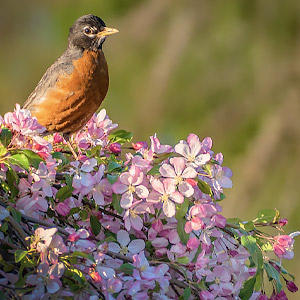
Towering shade trees
—maples and oaks—produce flowers in spring, but they are so small or high up that we can’t appreciate their unique beauty until they drift to the ground. Small to midsize ornamental trees, however, offer bold, beautiful color at eye level. They play an important role in small landscapes, especially in urban sites where this is no room for a large tree.
The individual flowers may be exceptionally small
—like those of the delightful Eastern redbud—but so plentiful and eye-popping that you just can’t miss them when the tree is in full bloom. Magnolias are also spectacular, but they have large, primitive-looking blossoms—think Jurassic Park. When the Garden’s magnolias begin to bloom in April and May, the display stops visitors in their tracks.
Paired with a carpet of spring-flowering bulbs—daffodils, crocuses, and grape hyacinths—a magnolia, serviceberry, redbud, or other small ornamental tree becomes the star of the season, providing a dose of enchantment for winter-weary gardeners.
Here are a few favorites for the home landscape
Pagoda dogwood
(Cornus alternifolia)
Pagoda dogwood, also called alternate-leaved dogwood, is an uncommon native tree occasionally found in the northern half of Illinois. The common name refers to the wide-spreading horizontal branches. The tree can be slow to establish but ultimately reaches a height and width of 15 to 25 feet or more. Many kinds of beneficial insects—long-tongued bees, short-tongued bees, wasps, flies, and butterflies—are attracted to the fragrant white blossoms. The flowers are followed by blue-black drupes (stone fruit) borne on pink-red stalks. The fruits won’t last long since birds find them tasty. Fall color is a golden yellow, making pagoda dogwood a desirable plant with multi-season interest.
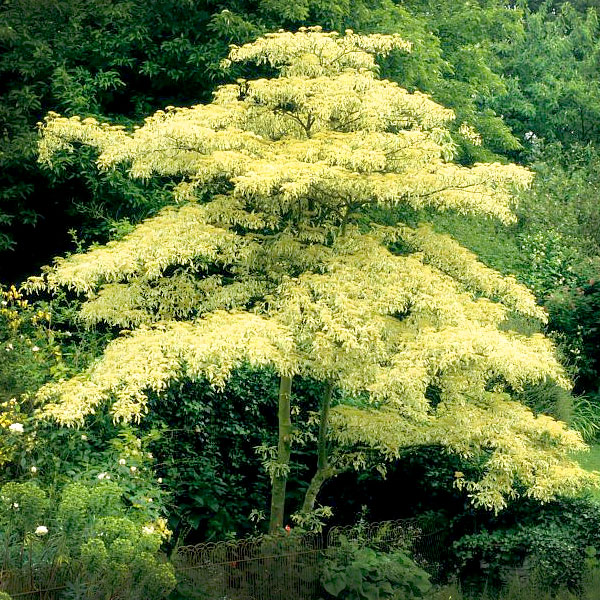
Star magnolia
(Magnolia stellata)
Magnolia trees are the prom dresses of the garden. Their magnificent showy flowers blanket the branches long before the leaves unfurl. The size, abundance and varied colors of the blossoms make magnolias one of the most stunning trees in spring. The white-flowered star magnolia and the pale pink saucer magnolia are popular trees for home landscapes, but there are many others from which to choose, including those with yellow, purple, red and bicolored flowers, and many that are fragrant. Mature star magnolias reach 15 to 20 feet tall and 10 to 15 feet wide.
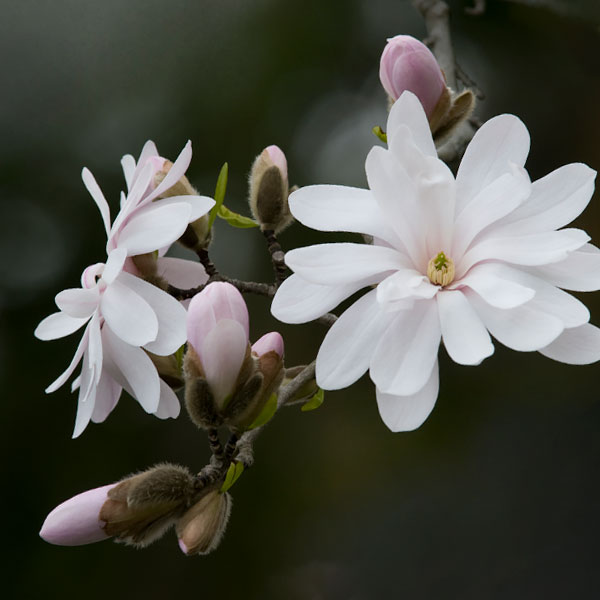
White fringetree
(Chionanthus virginicus)
The lightly fragrant, delicate flowers on this native plant make it a showstopper in spring. The flowers are followed by purple drupes and the fall color can be yellow-green to all yellow. A slow grower, this plant can reach 8 to 10 feet tall and wide in a decade. White fringetree can be planted as a single specimen or grouped together to create an outstanding hedge or woodland border. It’s also a good choice for a garden dedicated to native plants.

Apple serviceberry
(Amelanchier x grandiflora)
Illinois is home to a few species of serviceberry (Amelanchier). Apple serviceberry is a hybrid between two of our native trees, A. arborea x A. laevis. The cultivar ‘Autumn Brilliance’ produces flowers that blanket the multi-stemmed trees in April and May. The flowers are followed by blue berries that are quickly consumed by songbirds. As the leaves unfurl in spring, they have a purplish cast before turning green. Fall foliage is a striking red-orange. Apple serviceberry can reach 15 to 25 feet tall and can be used in a foundation planting off the corner of a building, in a border, or as an accent in the garden.
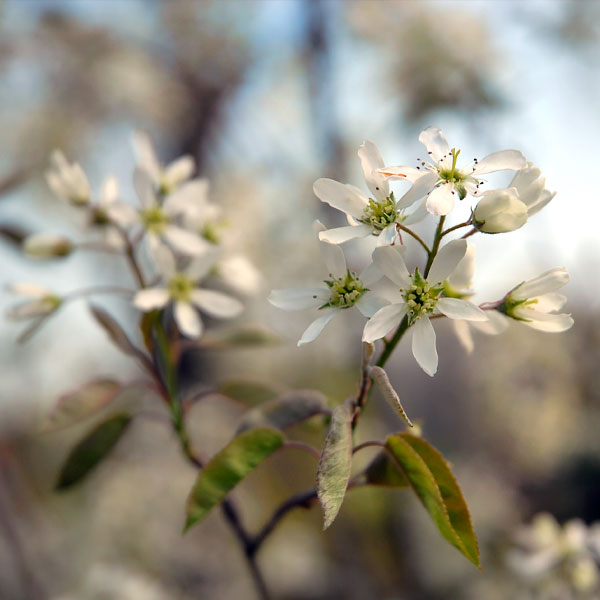
A flowering crabapple is the essence of spring in many gardens. There are hundreds of crabapple varieties, and they range in size and shape from dwarf and weeping forms to wide-spreading and upright. Buds on some crabapples are red-pink, opening to white flowers. Depending on the cultivar, flowers may be pink, coral-pink, coral-red, light purple-red, white, pink and white, and single or double. A bonus—flowers attract pollinators and some flowers offer a faint spicy fragrance. Trees put on a second show with fruits that can be yellow, bright red, dark purple-red, maroon, or a brilliant orange. Crabapples often get a bad rap because some are very susceptible to disease, especially after a wet spring. The Garden’s Plant Information desk can help you with a list of disease-resistant cultivars. Take a stroll this spring to see the Garden’s crabapples in bloom.
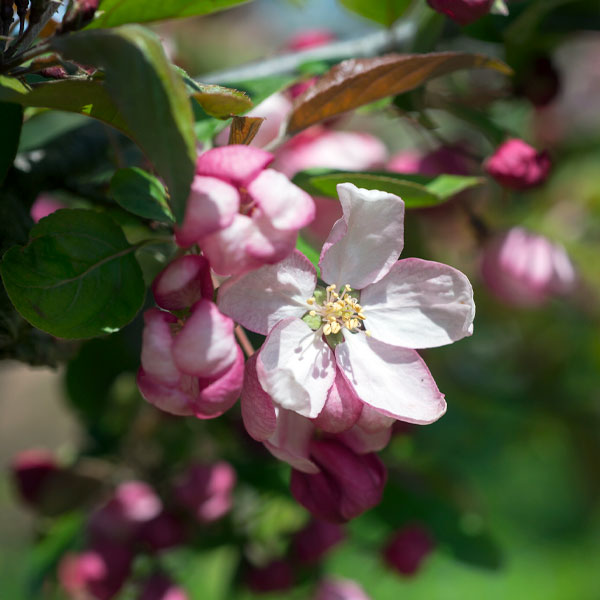
Cornelian cherry dogwood
(Cornus mas)
Dressed in clusters of yellow flowers, cornellian cherry dogwood makes a lovely individual specimen plant. It can be grown with a single trunk, but more often, cornelian cherry dogwoods are sold as multi-stemmed plants that are useful as a hedge or “living” fence. At maturity, the plants reach a height of 20 to 25 feet with a spread of 15 to 20 feet. Flowers are followed by bright, cherry-red drupes, and the fall foliage can have a purplish cast.
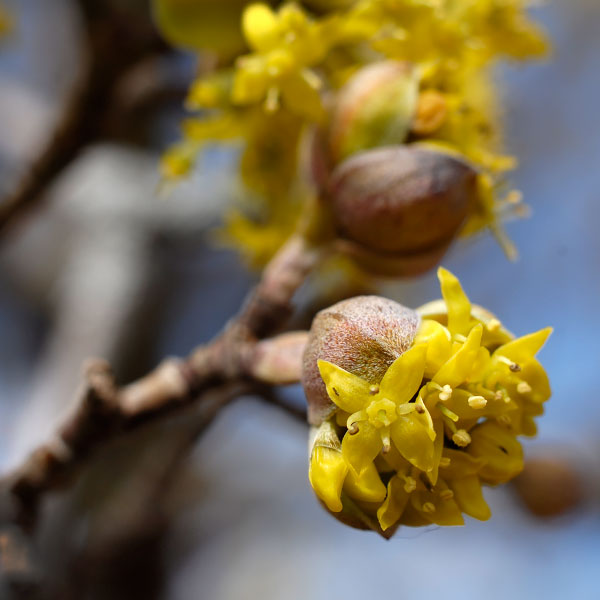
Eastern redbud
(Cercis canadensis)
Redbuds are small native trees with a mighty spring display of tiny reddish-purple flowers. Before the leaves unfurl, the trees produce a sensational number of blossoms that attract a wide variety of pollinators. Stand under a redbud in full flower on a quiet day and you can hear the bees buzzing overhead. Flowering is followed by green, heart-shaped leaves that turn a yellow-gold in autumn. Clusters of brown seedpods often remain dangling from the branches in winter. Mature redbuds can reach 20 to 30 feet in height and 25 to 35 feet in spread. You’ll find the weeping form (Cercis canadensis ‘Covey’) in the Circle Garden.
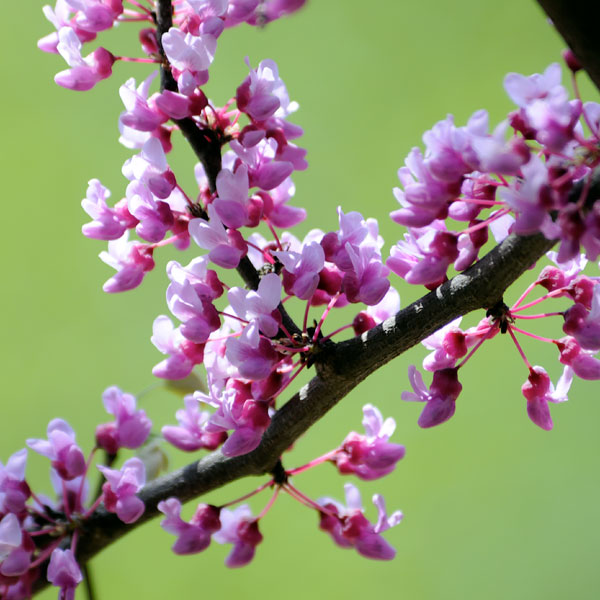
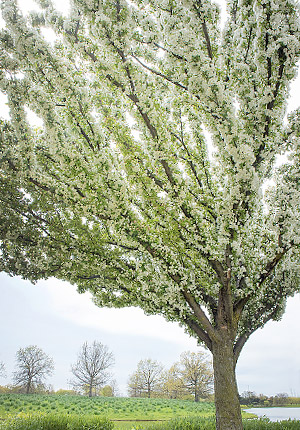
Find the Trees
Looking for a specific plant? Check out the Garden’s Plant Finder. Or, use our GardenGuide App 2.0 to find all of the interesting and unusual magnolias at the Garden.
Project Budburst
Scientists at the Chicago Botanic Garden and across the country use observations of when plants leaf out and bloom to draw conclusions about how changes in climate will impact agricultural production, the relationships between plants and their pollinators, and invasions of weedy species. Budburst allows people of all ages to engage in the scientific process and to contribute real, useful data to these important ongoing research projects. Join the fun!
Nina Koziol is a garden writer and horticulturist who lives and gardens in Palos Park, Illinois.

